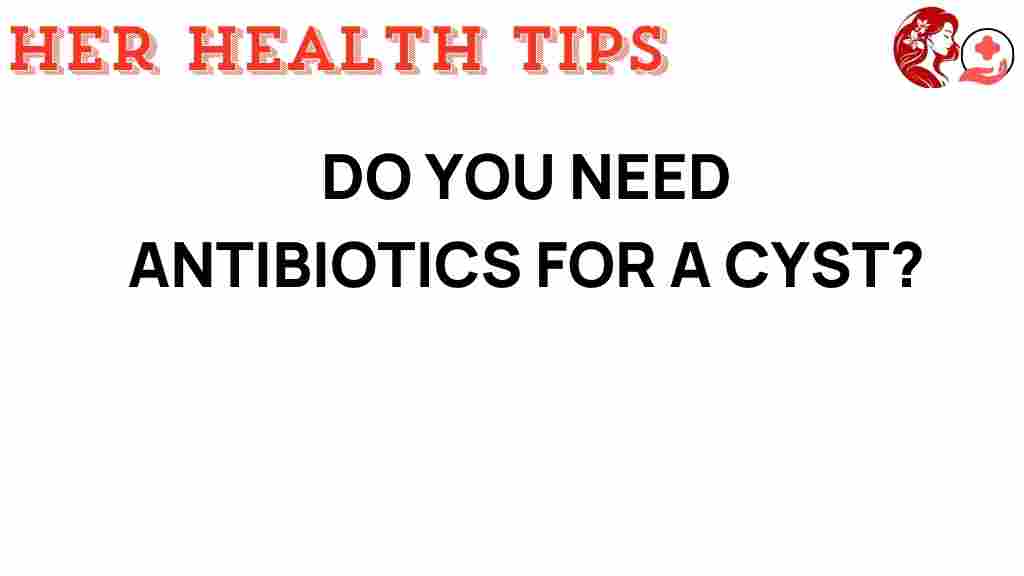Unraveling the Mystery: Are Antibiotics Necessary for a Cyst?
Cysts are common medical conditions that can occur in various parts of the body. They often raise questions regarding their treatment, especially when it comes to the use of antibiotics. In this article, we will explore the nature of cysts, their symptoms, and whether antibiotics play a role in their treatment. We aim to provide comprehensive health and medical advice to help you understand when antibiotics might be necessary and how to approach cyst treatment effectively.
Understanding Cysts
A cyst is a closed sac-like structure filled with fluid, pus, or other material. Cysts can develop in different tissues and organs, including the skin, ovaries, kidneys, and liver. They can be classified into various types, such as:
- Epidermoid cysts: These are small, benign cysts that form on the skin.
- Ovarian cysts: Fluid-filled sacs that develop on the ovaries.
- Sebaceous cysts: Often found on the scalp, neck, or back, these cysts form from blocked sebaceous glands.
- Breast cysts: Fluid-filled sacs that can develop in breast tissue.
While most cysts are harmless and may not require treatment, some can lead to complications or infections. Understanding the symptoms associated with cysts can aid in determining whether medical intervention is necessary.
Symptoms of Cysts
Symptoms can vary significantly depending on the location and type of cyst. Common symptoms include:
- Swelling: A noticeable lump or swelling in the affected area.
- Pain: Discomfort or pain if the cyst presses on surrounding tissues.
- Redness and warmth: Indications of inflammation, especially if the cyst is infected.
- Discharge: Pus or fluid leaking from the cyst.
If you experience any of these symptoms, it is important to consult a healthcare professional for an accurate diagnosis and appropriate treatment options.
Are Antibiotics Necessary for Cyst Treatment?
The necessity of antibiotics in cyst treatment largely depends on the presence of infection. Here’s a detailed breakdown:
- Non-infected cysts: Generally, antibiotics are not needed. Most cysts, such as epidermoid and sebaceous cysts, do not require antibiotic treatment unless they become infected.
- Infected cysts: If a cyst becomes infected, it can lead to symptoms such as increased pain, redness, swelling, and discharge. In these cases, antibiotics may be prescribed to combat the infection.
- Prevention of infections: Proper hygiene and care of the skin can help prevent the formation of infected cysts. Regularly cleaning the affected area and avoiding squeezing or rupturing cysts can minimize infection risk.
Consulting Healthcare Professionals
Before deciding on a course of action, it is crucial to seek medical advice from a healthcare professional. They can evaluate your specific situation and determine whether antibiotics are necessary based on:
- Your symptoms and their severity
- Physical examination results
- Medical history and any underlying health conditions
Sometimes, imaging tests like ultrasounds or CT scans may be required to gain a better understanding of the cyst and its potential impact on surrounding tissues.
Treatment Options for Cysts
When it comes to cyst treatment, options may vary based on the type of cyst and whether it is infected. Here are some common treatment methods:
- Observation: If a cyst is small and asymptomatic, your doctor may recommend monitoring it without immediate treatment.
- Drainage: In cases where a cyst is infected or causing discomfort, a healthcare professional may perform a minor procedure to drain the cyst.
- Surgical removal: For larger or recurrent cysts, surgical removal may be the best option. This is especially true for cysts that cause ongoing symptoms or have a risk of infection.
- Antibiotics: If an infection is present, antibiotics may be prescribed to help clear the infection and prevent further complications.
Home Remedies and Self-Care
While seeking medical advice is essential, there are also some self-care measures you can take to manage cysts and promote healing:
- Warm compress: Applying a warm compress to the cyst can help reduce inflammation and promote drainage.
- Keep it clean: Maintain good hygiene by washing the area with mild soap and water.
- Avoid squeezing: Do not attempt to squeeze or pop the cyst, as this can lead to infection.
- Monitor symptoms: Keep an eye on any changes in size, color, or pain level.
Preventing Cysts and Infections
Prevention is always better than cure. Here are some tips to help prevent cyst formation and infections:
- Maintain hygiene: Good personal hygiene can significantly reduce the risk of skin infections.
- Avoid tight clothing: Wearing loose-fitting clothes can prevent irritation and blockage of hair follicles.
- Manage underlying conditions: Conditions like acne or hormonal imbalances can contribute to cyst formation. Proper management can help reduce risk.
- Healthy lifestyle: A balanced diet and regular exercise can support your overall wellness and immune function.
Troubleshooting Tips
If you notice changes in your cyst or develop symptoms of infection, here are some steps to take:
- Assess symptoms: Note any changes in size, color, or pain level.
- Contact your healthcare provider: If symptoms worsen, reach out for medical advice promptly.
- Keep a record: Document any relevant details such as the duration of symptoms and any home treatments attempted.
Conclusion
Understanding cysts and their treatment options is essential for maintaining health and wellness. While antibiotics can be necessary for treating infections related to cysts, they are not always required for every cyst. It is crucial to consult with healthcare professionals for accurate diagnosis and appropriate treatment. By staying informed about symptoms, prevention strategies, and treatment options, you can effectively manage your health and reduce the risk of complications associated with cysts.
For more detailed medical advice on cysts and their treatment, consider visiting your local healthcare provider or checking out resources like the CDC website for more information on infections and antibiotic use.
This article is in the category Conditions and created by HerHealthTips Team
